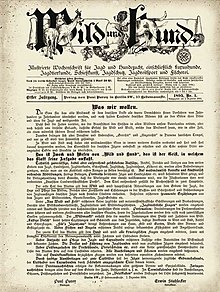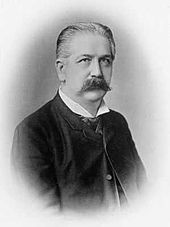Paul Parey
Theodor Wilhelm Paul Parey (born March 23, 1842 in Berlin , † March 31, 1900 in Berlin) was a German publisher , bookseller and chairman of the German Stock Exchange Association . He became particularly well known as a publisher of scientific , agricultural and hunting magazines and books that were published by his Paul Parey Verlag in Berlin.
life and work
Education and years in the military
Paul Parey comes from a Berlin merchant family. He attended high school in his hometown and began training as a bookseller in the Amelang bookstore in 1859. His teacher was the bookseller and publisher Rudolph Gaertner , who taught Parey not only the book trade, but also the basics of publishing. After completing his training, he attended various lectures at the University of Berlin and then went to the Georg & Co. bookstore in Geneva .
In 1865 Parey returned to Berlin to do his military service . In 1866, at the age of one , he was ordered to the front in the German War with the Emperor Franz Garde Grenadier Regiment No. 2 and went to war as a sergeant . After his first military service in 1866, Paul Parey worked briefly in the publishing house of the "Bazar" and then in 1867 joined Wiegandt & Hempel , a publishing house for theological and agricultural writings, as managing director .
Development of the company Wiegandt & Hempel to Paul Parey Verlag
The Wiegandt & Hempel company was founded in 1862 by purchasing the publishing house from Gustav Bosselmann. Karl Wiegandt and Gustav Hempel founded this company under the name Wiegandts in 1848 and continued it under the Wiegandt & Grieben company after Leo Grieben joined in 1850 . In 1853 Greaves were separated, whereupon Wiegandt independently continued part of the publishing house that was later ceded to Bosselmann. Karl Wiegandt died on October 5th, 1867 and Gustav Hempel was not able to continue running this company in addition to his own publishing house. He hired Paul Parey in 1867. From 1869 Parey was co-owner of the publishing house, which was renamed Wiegandt, Hempel & Parey .
However, Parey was drafted into the military again in 1870 to fight as a reserve officer in the Franco-German War . He was wounded in the battle of Gravelotte and later fought outside Paris . After the peace treaty he returned to Berlin , decorated with the Iron Cross , and continued to work for the Wiegandt, Hempel & Parey publishing house .
Gustav Hempel died on January 13, 1877 and Paul Parey became the sole owner of the publishing house, which he renamed Paul Parey Verlag in 1881 . The publishing program continued to focus on the publication of agricultural books and the publishing house developed into one of the most important publishers in this field in Germany.
Program development by Paul Parey Verlag
While Wiegandt & Hempel were among the lesser-known publishers in Germany and were also rather modestly represented in the field of agricultural literature, this changed when Parey joined the company. He expanded the program to related subjects, especially forestry , veterinary medicine and horticulture . He also tried to continuously improve the quality of the products. The first-class images in particular have become a trademark of Parey's products.
In 1874 he founded the magazine "Die deutsche Landwirtschaftliche Presse", which developed into one of the most important periodicals until after 1900. From December 14, 1883, the weekly for brewery appeared in the Paul Parey publishing house in Berlin, which was published by the newly founded experimental and educational institute for brewing . With the founding of “ Wild und Hund ” in 1894, he succeeded in establishing another important magazine that has developed into the hunting magazine with the highest circulation to this day. By this time the publishing program had grown to over 1,000 titles and Parey was the editor of 14 specialist magazines in the fields of agriculture and hunting .
Rudolf Schmidt describes Parey's publishing work in the following words:
“Parey's independent bookselling activity has been one of the most successful that the German book trade has to show. He had familiarized himself with the area he had chosen for his publishing activity, agriculture to the greatest extent, in such a way that no need for this profession, scientific or practical, remained hidden from him. With admirable insight he recognized the gaps in agricultural literature, he followed every advance of science, every stimulus that came from the practical work of farmers, and he also had a keen sense of the judgment of the abilities of the people he chose chose to carry out his plans. In this way he almost always found the right men with whose help he turned his ideas into reality, and with the energy of his will, for whom there was hardly any obstacle, he was always the best helper and promoter of their work. "
Representing the interests of the publishing and book trade
In addition to his actual work as a publisher, Paul Parey campaigned very intensively for the interests of the German publishing industry and book trade. For many years he was on the boards of the Berlin Booksellers Association , the Berlin Booksellers Corporation and the German Booksellers Association (today the German Booksellers Association ).
Above all, he supported the reform efforts of Adolf Kröner , who was the first chairman of the German Booksellers Association from 1882 to 1888 . Parey was second chairman at the same time and replaced Kröner as first chairman in 1888 after the changes known as "Kröner reforms" had been implemented in the book trade. This mainly affected the fixed book prices that were introduced in Germany with this reform. Parey tried to implement this reform vigorously and to enforce it against the publishers by means of coercive measures. However, he failed because his colleagues resisted such a rapid implementation. Accordingly, Parey was replaced by Kröner after just one year in office.
Paul Parey also promoted the construction of the Kaiser Wilhelm library in Posen and established in his will that Paul Parey Foundation at the University of Halle , where he in 1894 for honorary doctorate was appointed (Dr. phil. E. C.).
Death and inheritance
Paul Parey died on March 31, 1900 at the age of 58 in Berlin. Since he had no children himself, he passed the management of the bookstore on to his former colleague Arthur Georgi from Leipzig. Parey was buried in the old St.-Matthäus-Kirchhof Berlin in Berlin-Schöneberg . The tomb for him and his wife Luise, née Molenaar, who died in 1898, is no longer completely preserved in its current condition, is located on the west wall of the cemetery and was designed by the renowned architects Heinrich Kayser and Karl von Großheim , who also designed the neo-Gothic Villa Parey created in the Tiergarten district.
literature
- Karl Friedrich Pfau : Biographical lexicon of the German book trade of the present: taking into account the most outstanding representatives of the book trade of the old days and abroad . Leipzig 1890.
- Paul Parey † . In: The agricultural test stations , Volume 55, 1901, pp. 1-7 (with picture).
- Ernst Vollert : Parey, Paul . In: Biographisches Jahrbuch und Deutscher Nekrolog , Volume 6, 1901 (1904), pp. 479-481.
- Friedrich Georgi: Paul Parey publishing house, 125 years old , introduction to the Paul Parey general catalog 1848–1972 . Paul Parey Verlag, Berlin 1972.
- Mark Lehmstedt (Hrsg.): History of the German book trade . Directmedia Publishing, Berlin 2000/2004 (CD-ROM).
- Regina Mahlke: Parey, Paul. In: New German Biography (NDB). Volume 20, Duncker & Humblot, Berlin 2001, ISBN 3-428-00201-6 , p. 67 ( digitized version ).
- Albrecht Milnik : Paul Parey . In ders. (Ed.) Et al .: In the service of the forest - life paths and achievements of Brandenburg forest people. Brandenburg pictures of life . Verlag Kessel, Remagen-Oberwinter 2006, ISBN 3-935638-79-5 , pp. 279-280
Web links
- Publishing history. Paul Parey Publishing House
Individual evidence
- ↑ after Ernst Vollert 1904
- ↑ sperrzone.net
- ↑ to paulparey.de ( Memento of the original from May 1, 2006 in the Internet Archive ) Info: The archive link was inserted automatically and has not yet been checked. Please check the original and archive link according to the instructions and then remove this notice. (May 18, 2006)
- ^ Rudolf Schmidt: German booksellers. German book printer. Contributions to a company history of the German book industry . Volume 1 to 6 Verlag der Buchdruckerei Franz Weber (later: Verlag von Rudolf Schmidt, Eberswalde), Berlin 1902–1908. ( Full text )
- ↑ after Ernst Vollert 1904
- ^ Hans-Jürgen Mende : Lexicon of Berlin tombs . Haude & Spenersche Verlagbuchhandlung, Berlin 2006, ISBN 3-7759-0476-X
- ↑ http://www.stadtentwicklung.berlin.de/denkmal/liste_karte_datenbank/de/denkmaldatenbank/daobj.php?obj_dok_nr=09050289
| personal data | |
|---|---|
| SURNAME | Parey, Paul |
| ALTERNATIVE NAMES | Parey, Theodor Wilhelm Paul (full name) |
| BRIEF DESCRIPTION | German publisher and chairman of the German Booksellers Association |
| DATE OF BIRTH | March 23, 1842 |
| PLACE OF BIRTH | Berlin |
| DATE OF DEATH | March 31, 1900 |
| Place of death | Berlin |



